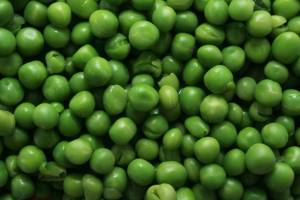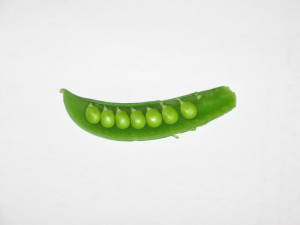Peas are a legume that were grown as long ago as the 7000 B.C. Peas have been a popular food ever since and remain a key part of many Western dishes to this day. For much of their life span they were actually eaten dried – it wasn’t until the 1500s that a sweet, cook-able variety was developed. Peas have been particularly popular in English cuisine over the last few centuries.
Varities of Peas
Peas come in two major varieties – smooth seeded and wrinkle seeded. Wrinkle seeded varieties are a bit sweeter but not as hardy. The common garden pea is sometimes referred to as the English Pea. There are also snow peas, which are especially sweet and come in edible pods, and snap peas, which are about in between the two.
Planting Peas
Peas grow best in cool temperatures around 15°C. Anything over 20°C will hurt production. They therefore do not suit tropical regions well but can be grown in all other climates. Peas do not like frost or excessive moisture – a cool, breezy climate is ideal. In some colder parts of the planet this may be during summer; in others during winter. Speak to a local nursery or expert about when to plant.
Peas do not grow well from seed when soil temperatures are less than 10°C. They can be sown every fortnight for a continuous yield. Prepare the soil using an organic matter a month before sowing. The pH of the soil should be between 6 and 7.
Plant peas in rows 2 inches (5cm) deep and 1 foot (30cm) apart. The soil should be moist when the seeds are sown. A challenge with peas is to not let them come in contact with fertilizer. When preparing the soil, it’s okay to use a fertilizer at the bottom of the trenches but make sure that it is covered with a layer of soil afterward.
Growing Peas
Hold off on watering peas until seedlings emerge. After that, water regularly but not excessively. Peas will do well enough with an occasional watering complemented by an occasional drop of rain. Soil must be able to drain well or the plants will grow poorly and be prone to disease. Water at the base of plant to try and prevent leaf disease. A good layer of mulch will keep weeds down and preserve moisture.
Some varieties of peas climb and will therefore need trellising to support them. They will grow up most things without much effort – just make sure to put the trellising in before sowing seed to avoid any damage to the root system.
Some small varieties of peas can be grown in large containers. They will probably need a small trellis for support. Water a bit more regularly in pots than if they were in the ground, as the soil is harder to keep moist.
Harvesting Peas
Peas typically take 50 to 80 days to reach maturity. It’s a good idea to pick pods off the plant every day to promote continuous growth. A good time to harvest is 3 weeks after the plant has blossomed. It is possible to leave it too late, demonstrated by the pods lightening in color and negatively affecting the taste.
If you have ever spent any time in the frozen section of the supermarket you will realize that peas freeze well! Blanch for 1.5 minutes, drain and freeze in a seal-able bag. Do this as soon as possible after picking to retain the most flavor.
Threats to Peas
Powdery and downy mildew are the biggest problems. Avoid watering the plant directly – always water around the base.
Peas are not usually plagued by any bugs, but birds can sometimes get at the crop. They may require protection through netting.


